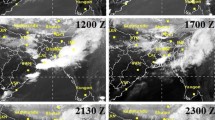Abstract
Analyzed is a development of cloud convective system of short duration accompanied by severe thunderstorms, showers, squalls up to 22 m/s, and hail with the diameter reaching 20 mm and more in the afternoon on June 9, 2012 on the territory of Perm krai. An assessment of the convection development using the WRF-ARW model demonstrated that it simulates adequately the formation of convective systems on the territory of Perm krai. However, the zones of intensive precipitation coincide with its actual distribution not always. The Grell-Devenyi parameterization of convection gives the best results. The model does not simulate the hail formation processes: despite the fact of the development of this phenomenon on the territory of Perm krai on June 9, 2012, no hail formation was predicted by the model computations within the computational domain.
Similar content being viewed by others
References
N. F. Vel’tishchev and V. D. Zhupanov, “Experiments on the Radar Reflectivity Data Assimilation in the WRF-ARW Model,” Meteorol. Gidrol., No. 3 (2012) [Russ. Meteorol. Hydrol., No. 3, 37 (2012)].
N. F. Vel’tishchev and V. D. Zhupanov, “Experiments on Numerical Modeling of Intense Convection,” Meteorol. Gidrol., No. 9 (2008) [Russ. Meteorol. Hydrol., No. 9, 33 (2008)].
N. F. Vel’tishchev, V. D. Zhupanov, and Yu. B. Pavlyukov “Short-range Forecast of Heavy Precipitation and Strong Wind Using the Convection-allowing WRF Models,” Meteorol. Gidrol., No. 1 (2011) [Russ. Meteorol. Hydrol., No. 1, 36 (2011)].
R. M. Vil’fand, G. S. Rivin, and I. A. Rozinkina, “Mesoscale Weather Short-range Forecasting at the Hydrometcenter of Russia, on the Example of COSMO-RU,” Meteorol. Gidrol., No. 1 (2010) [Russ. Meteorol. Hydrol., No. 1, 35 (2010)].
R. M. Vil’fand, G. S. Rivin, and I. A. Rozinkina, “COSMO-RU System of Nonhydrostatic Mesoscale Short-range Weather Forecast of the Hydrometcenter of Russia: the First Stage of Realization and Development,” Meteorol. Gidrol., No. 8 (2010) [Russ. Meteorol. Hydrol., No. 8, 35 (2010)].
L. V. Gonchukov and B. E. Lamash, “Numerical Forecast of Hazardous Weather Phenomena in the North of Primorskii Krai,” Vestnik Dal’nevostochnogo Otdeleniya RAN, No. 6 (2010) [in Russian].
N. A. Kalinin and A. A. Smirnova, “Study of Radar Characteristics for Detection of Hazardous Weather Associated with Cumulonimbus Clouds,” Meteorol. Gidrol., No. 1 (2005) [Russ. Meteorol. Hydrol., No. 1 (2005)].
N. A. Kalinin and A. A. Smirnova, “Determination of Liquid Water Content and Reserve of Cumulonimbus Cloudiness from Meteorological Radar Information,” Meteorol. Gidrol., No. 2 (2011) [Russ. Meteorol. Hydrol., No. 2, 36 (2011)].
N. A. Kalinin and A. A. Smirnova, “Combined Use of Radar and Station Data for Analysis of Cloud Fields,” Meteorol. Gidrol., No. 8 (2002) [Russ. Meteorol. Hydrol., No. 8 (2002)].
N. A. Kalinin and A. A. Smirnova, “Numerical Analysis of Radar and Station Cloud Observation,” Meteorol. Gidrol., No. 7 (2003) [Russ. Meteorol. Hydrol., No. 7 (2003)].
L. I. Kizhner, D. P. Nakhtigalova, and A. A. Bart, “The Use of WRF Forecasting Model for Studying Weather in Tomsk Oblast,” Vestnik Tomskogo Gosudarstvennogo Universiteta, No. 358 (2012) [in Russian].
Zh. Lkhamzhavyn, Ts. Manalzhavyn, and V. K. Arguchintsev, “Studing Convection Using Kain-Fritsch Numerical Model,” Izvestiya Irkutskogo Gosudarstvennogo Universiteta, Seriya Nauki o Zemle, No. 1, 5 (2012) [in Russian].
B. E. Peskov and T. G. Dmitrieva, “Specifying the Mesoscale Numerical Forecast of Heavy Showers,” Meteorol. Gidrol., No. 9 (2010) [Russ. Meteorol. Hydrol., No. 9, 35 (2010)].
Regulations for the Order of Actions of Institutions and Organizations in Case of the Danger of Formation and the Formation of Hazardous Natural Phenomena. RD 52.88.699-2008 (Moscow, 2008) [in Russian].
E. A. Aligo and W. A. Gallus, “On the Impact of WRF Model Vertical Grid Resolution on Midwest Summer Rainfall Forecasts,” Wea. Forecasting, No. 2, 24 (2009).
W. A. Gallus and M. Pfeifer, “Intercomparison of Simulations Using 5WRF Microphysical Schemes with Dual-Polarization Data for a German Squall Line,” Geosci., 16 (2008).
I. Jankov, J.-W. Bao, P. J. Neiman, et al., “Evaluation and Comparison of Microphysical Algorithms in ARW-WRF Model Simulations of Atmospheric River Events Affecting the California Coast,” J. Hydrometeorol., 10 (2009).
A. J. Litta, U. C. Mohanty, S. Das, and S. Mary Indicula, “Numerical Simulation of Severe Local Storms over East India Using WRF-NMM Mesoscale Model,” Atmos. Res., 116 (2012).
G. Thompson et al., “Explicit Forecasts of Winter Precipitation Using an Improved Bulk Microphysics Scheme. Part II: Implementation of a New Snow Parameterization,” Mon. Wea. Rev., No. 12, 136 (2008).
Author information
Authors and Affiliations
Additional information
Original Russian Text © N.A. Kalinin, A.L. Vetrov, E.M. Sviyazov, E.V. Popova, 2013, published in Meteorologiya i Gidrologiya, 2013, No. 9, pp. 21—30.
About this article
Cite this article
Kalinin, N.A., Vetrov, A.L., Sviyazov, E.M. et al. Studying intensive convection in Perm krai using the WRF model. Russ. Meteorol. Hydrol. 38, 598–604 (2013). https://doi.org/10.3103/S1068373913090021
Received:
Published:
Issue Date:
DOI: https://doi.org/10.3103/S1068373913090021




